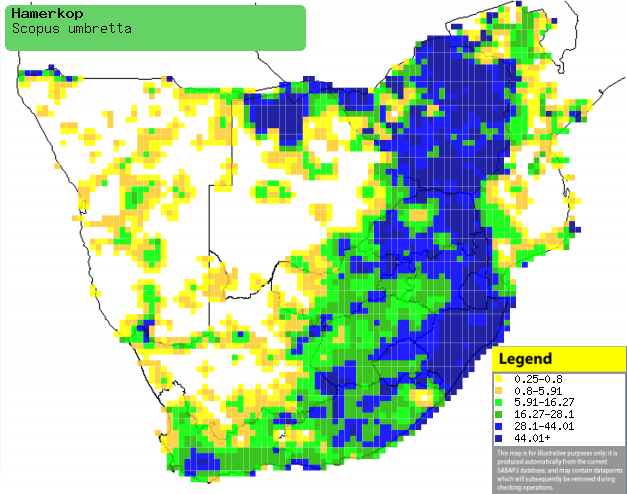|
Scopus umbretta (Hamerkop)
Hamerkop [Afrikaans]; Uqhimngqoshe, Uthekwane [Xhosa];
uThekwane [Zulu]; Mfune [Kwangali]; Mamasianoke, Masianoke [South Sotho];
vaKondo [Shona]; Tsekwane [Swazi]; Mandonzwana [Tsonga]; Mmamasiloanokę
[Tswana]; Hamerkop [Dutch]; Ombrette africaine [French]; Hammerkopf [German];
Pássaro-martelo [Portuguese]
Life
> Eukaryotes >
Opisthokonta
> Metazoa (animals) >
Bilateria >
Deuterostomia > Chordata >
Craniata > Vertebrata (vertebrates) > Gnathostomata (jawed
vertebrates) > Teleostomi (teleost fish) > Osteichthyes (bony fish) > Class:
Sarcopterygii (lobe-finned
fish) > Stegocephalia (terrestrial
vertebrates) > Tetrapoda
(four-legged vertebrates) > Reptiliomorpha > Amniota >
Reptilia (reptiles) >
Romeriida > Diapsida > Archosauromorpha > Archosauria >
Dinosauria
(dinosaurs) > Saurischia > Theropoda (bipedal predatory dinosaurs) >
Coelurosauria > Maniraptora > Aves (birds) > Order: Ciconiiformes
> Family: Scopidae
Distribution and habitat
Occurs in south-western Arabia, Madagascar and
sub-Saharan Africa. It
is locally common across southern Africa, although scarce to absent in the
arid western region. It
generally favours the shallow margins of lakes, pans, swamps, rivers, marshes,
streams, seasonally flooded ponds and even small puddles in gravel roads.
|
 |
|
Distribution of Hamerkop in southern Africa,
based on statistical smoothing of the records from first SA Bird Atlas
Project (©
Animal Demography unit, University of
Cape Town; smoothing by Birgit Erni and Francesca Little). Colours range
from dark blue (most common) through to yellow (least common).
See here for the latest distribution
from the SABAP2. |
Predators and parasites
- Predators
- of eggs and nestlings
- of adults
Movements and migrations
Mainly sedentary, although it may move locally in response to food availability,
Food
It eats mainly the adults and tadpoles of platanna frogs (Xenopus), which have a very similar distribution to the Hamerkop, suggesting that it
is dependent on them for food. It also eats other frogs, small fish and insects, using
a variety of foraging techniques, such as wading through the water and stabbing
prey, still-hunting at the water's edge or pouncing on prey from the air. It has
also been observed robbing Hadedas of earthworms that they pulled up from a
sports field (HG Robertson personal observation). The following food items have been recorded
in its diet:
- Vertebrates
- amphibians
- Xenopus (frogs)
- frogs
- Hildebrandtia
- Phrynomerus
- Tomopterna
- Bufo gutturalis (Guttural toad). See Bussičre & Loftie-Eaton
(2012) who observed Milvus parasitus (Yellow-billed kite) robbing a
Hamerkop of a Guttural toad it had just caught.
- small fish
- Amphilus uranoscopus (Stargazer mountain catfish)
- Barbus
- Clarias
- Tilapia
- goldfish from ornamental fish ponds
- small mammals
- eggs and chicks of
Vanellus
coronatus (Crowned lapwing)
- Invertebrates
- insects
- Eristalis (maggots)
- earthworms
- shrimps
Breeding
- Monogamous solitary nester.
- The nest (see image below) is usually built by both sexes, or rarely a group of up to seven
birds, with construction taking anything from 40-43 days to several months.
It consists of a uniquely-shaped, large pile of material with an interior chamber
and entrance low down on the side. At first, a supporting structure of sticks
similar to an inverted pyramid is laid down. The walls are then built by
interlocking twigs and finally the whole structure is covered with
stalks, sticks, reeds, grass and twigs, while it often decorates it with a
variety of both natural and
man-made materials, including cardboard, plastic, leaves, bark, aloe stems
and stones and wool. It is typically
placed in a tree over or next to water, occasionally on a bridge, dam,
wall, house or even on the ground. Other animals often usurp the nest of the Hamerkop, such as bees, reptiles and other birds,
including Barn owls and
Black sparrowhawks.
- Egg-laying season is almost year-round, peaking from August-September in
Zimbabwe and from July-January in South Africa.
- It lays 3-9 eggs, which are incubated by both adults for about 26-30
days.
- The chicks leave the nest after 45-50 days and can fly strongly a
few days later.
Threats
Not threatened, in fact it has probably benefited from the
introduction of man-made impoundments.
References
-
Bussičre E, Loftie-Eaton M. 2012. When a Hamerkop and
Yellow-billed Kites fight for a Guttural Toad. Ornithological Observations
3: 125-128. (pdf)
-
Hockey PAR, Dean WRJ and Ryan PG 2005. Roberts
- Birds of southern Africa, VIIth ed. The Trustees of the John Voelcker
Bird Book Fund, Cape Town.
|
